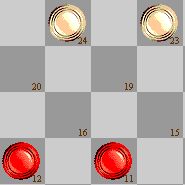| history First refere
nces to checkers game are found as early as 1600 B.C in Egyptian
paintings and inscriptions at time of the Pharaohs. In England and Scotland this game is
called 'draughts' (pronounced as 'drafts'). There are many versions played
worldwide. At PlayJava you can play one of the most popular -- Anglo-American
version (see information on other versions here). |
|
| basics and rules |
 |
Checkers is a game for two players.
It is played on an 8x8 checkered board, with a dark square in each player's lower left
corner. Pieces move only on dark squares which are numbered. Numbers are used to record the moves, for example, if Red moves from
square 9 to square 13, then it is recorded as: 9-13
Each player controls its own army of pieces (men). The player who
controls Red pieces moves first. The pieces (also known as 'men') are arranged as
shown on the left.
The goal in the checkers game is either to
capture all of the opponent's pieces or to blockade them. If neither player can accomplish
the above, the game is a draw.
|
When you play online in the playing
area, you can move the pieces on the board. To move a piece on the board,
a player clicks on it with the mouse, drags it to its destination square, and releases the
mouse. |
|
|
| There are several varieties of Checkers. GameColony
offers you the most popular Anglo-American checkers (called draughts in England). The
oldest known checkers rules book was published in 1549! The present-day rules are
presented below. |
| Moves in checkers game Starting with Red, the players take turns moving one of their own pieces. A
'piece' means either a 'man'--an ordinary single checker or a 'king' which is what a man
becomes if it reaches the last rank (see kings).
A man may move one square diagonally only forward--that is, toward the opponent--onto an
empty square. Thus, on the diagram on the right-hand side, the red pieces can move 12-16,
11-16 or 11-15. Similarly, the white pieces can move 24-20, 24-19 or 23-19. |
 |
|
|
| Captures ('Jumps')
Checkers rules state tht captures or 'jumps' are mandatory. If a
square diagonally in front of a man is occupied by an opponent's piece, and if the square
beyond that piece in the same direction is empty, the man may 'jump' over the opponent's
piece and land on the empty square. The opponent's piece is captured and removed from the
board. Thus, on the diagram on the right-hand side red can 'jump' 14-21, leaving
square (where white man used to stand) 17 empty. Similarly, if it were white turn to move,
the white man could 'jump' over its red counterpart 17-10, leaving square 14 empty.
If in the course of single or multiple jumps the man reaches the
last rank, becoming a king, the turn shifts to the opponent. No further 'continuation'
jump is possible |
 |
|
|
|
| The kings
When a single piece reaches the last rank of the board by reason of a move,
or as the completion of a 'jump', it becomes a king; and that completes the move, or
'jump'
A king can move in any direction and 'jump' in any direction one or
more pieces, as the limits of the board permit. The king can only jump diagonally over one
adjacent piece at a time, in any of the four diagonal directions. Multiple jumps are
possible. |
|
| |
|
Play Checkers Tournaments Online * Home
|

